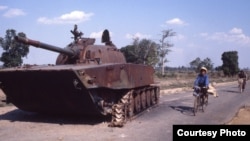A new photo exhibition showing the daily life of Cambodians in the aftermath of the Khmer Rouge regime will help young Cambodians understand the struggles of their parents’ generation, according to its organizer.
John Burgess, an American author and former Washington Post journalist, will launch the exhibition, titled “Cambodia Reawakening: One Year After the Khmer Rouge”, on Wednesday at Footprint Cafe in Siem Reap. It will run until May 17.
The photos chart the journey Burgess took from his arrival in Phnom Penh in April 1980 to Siem Reap and Battambang.
Nancy Barrett, a spokeswoman for Anjali House, an educational NGO that co-organized the event, said alongside the photos the gallery was running text, essays and poems written by young Cambodians reacting to the images.
“The younger generation of Cambodians should know about the past and should also reflect, because they represent the future of the country. So that’s why it’s very important today that they know what happened and they reflect on it,” she said.
Since 1971 until the late 1980s, Burgess reported from Asia as a freelancer and for the Post, where he was its first technology editor.
He has authored several books since retiring in 2008, most recently “The Stairway Guide’s Daughter”, a novel set in 12th century Preah Vihear province.
Burgess told VOA Khmer in a phone interview from Washington DC that he hoped a new generation of Cambodians would gain a greater understanding of the hardships faced by their parents, engendering a closer relationship between generations.
“Maybe these photos will allow young Cambodians to better appreciate what their parents and grandparents experienced and why their grandparents and parents are, how they are today. Maybe this will give young Cambodians a real appreciation of the sacrifice and the energy that people needed back in those times,” he said.
Tep Sokly, 14, one of the children who penned reflections on the photos that will be displayed alongside Burgess’ work, said she had heard many stories from her parents and grandparents about the Khmer Rouge period and its aftermath, but the stories had seemed unreal until she saw the collection of images due to go on show at Anjali House.
“I admire them most because they could endure those difficulties and tried to go on living despite the suffering. They are good at enduring [hardship],” she said.
Youk Chhang, director of the Documentation Center of Cambodia (DC-Cam), said exhibitions such as this helped to rebuild Cambodian society.
“What happened in the 1980s or during the Khmer Rouge regime has a relationship with everything at the present time. Why is that? Because there are 15 million people in Cambodia, all of those people are survivors or children of survivors of the Khmer Rouge regime,” he said.
“So in any form, we cannot run away from history. So exhibiting such photos is a reflection to the present time for those who went through it,” he added.









